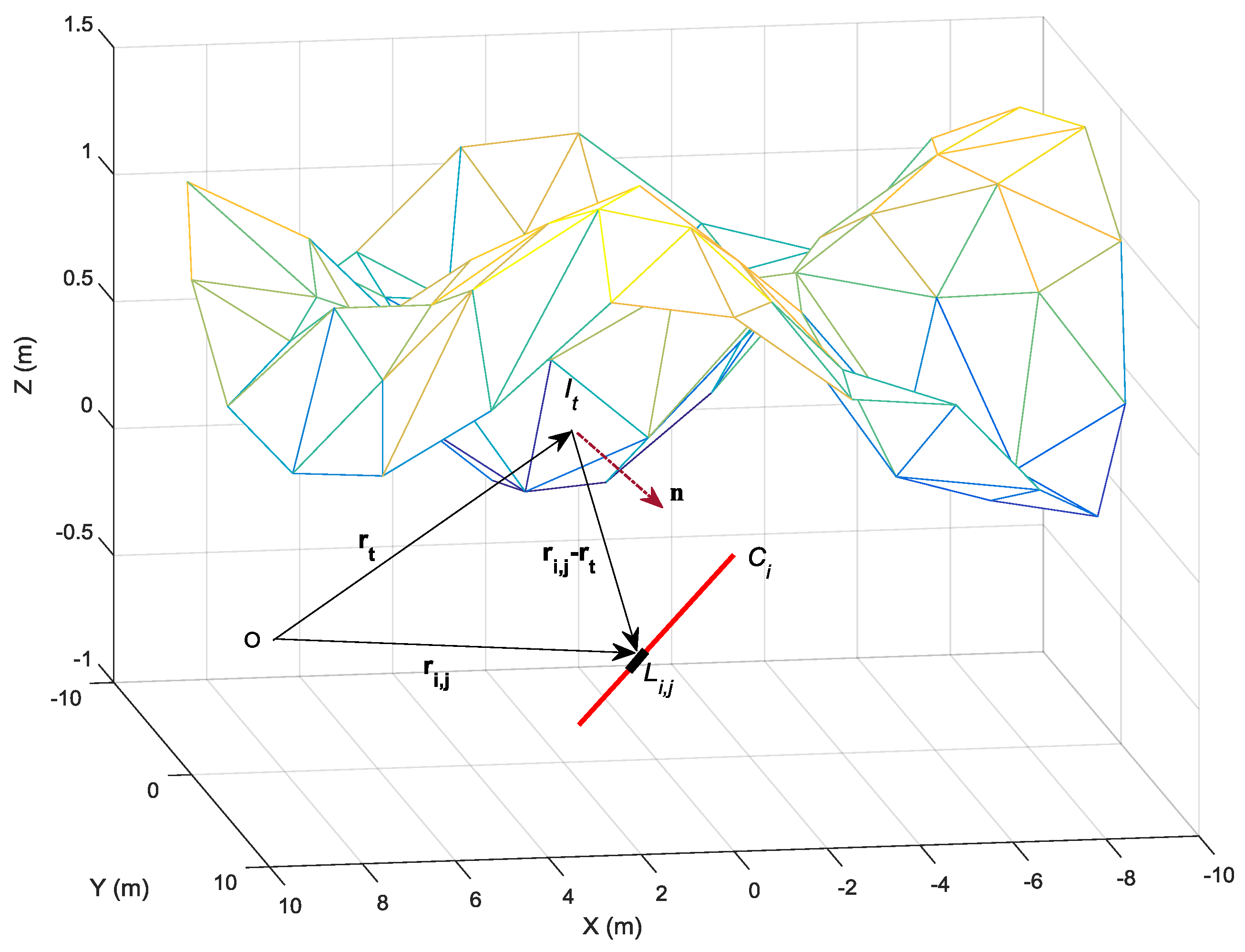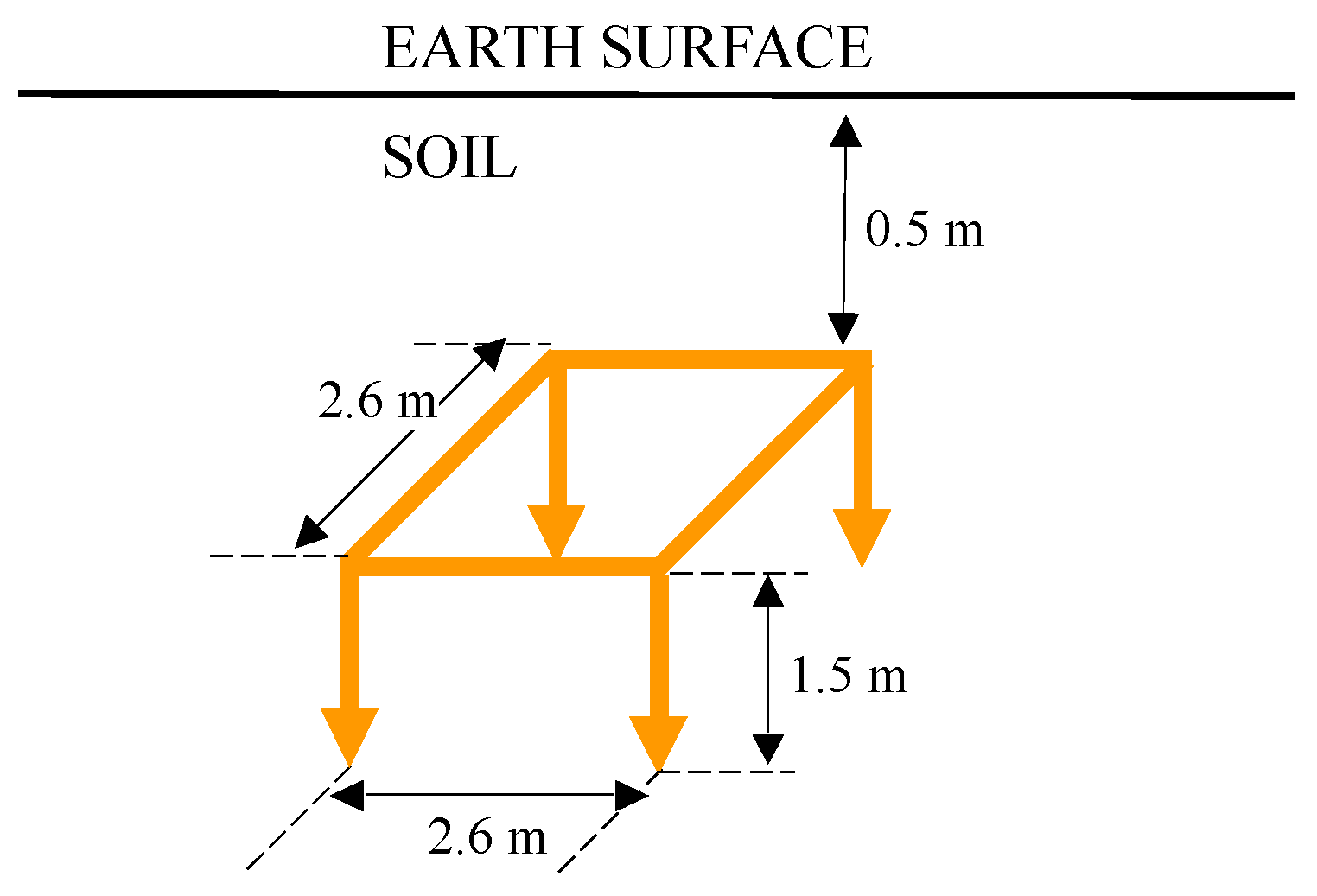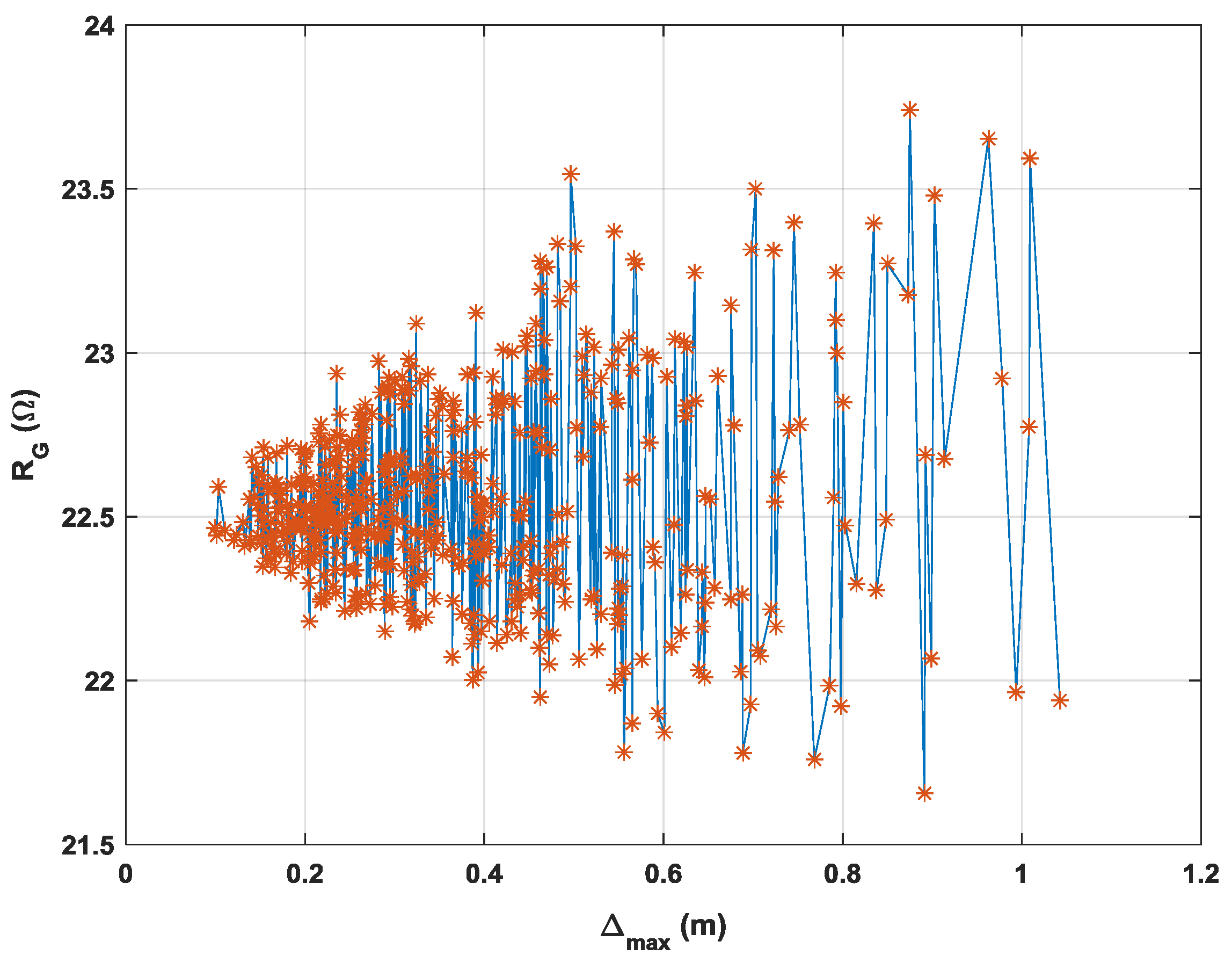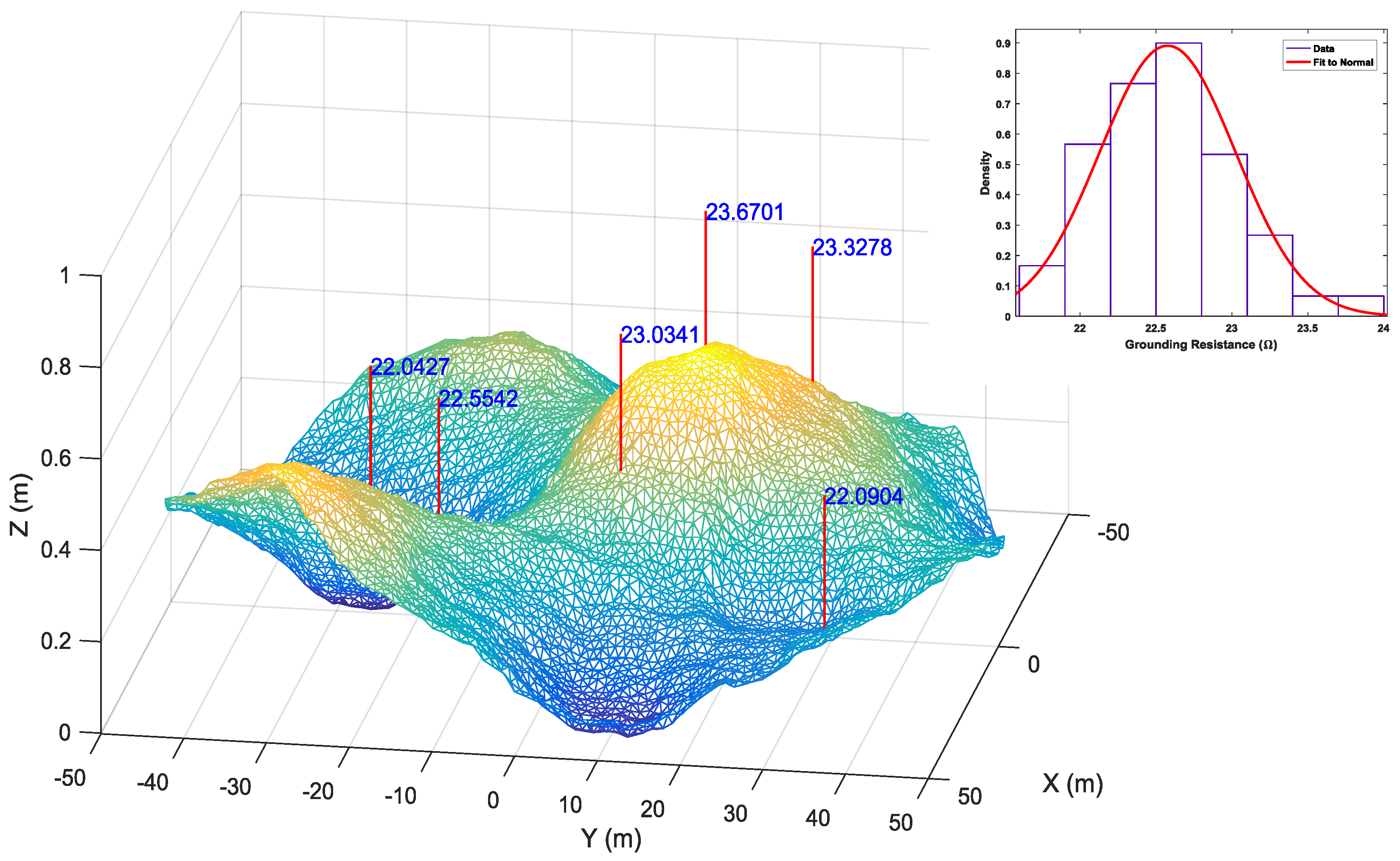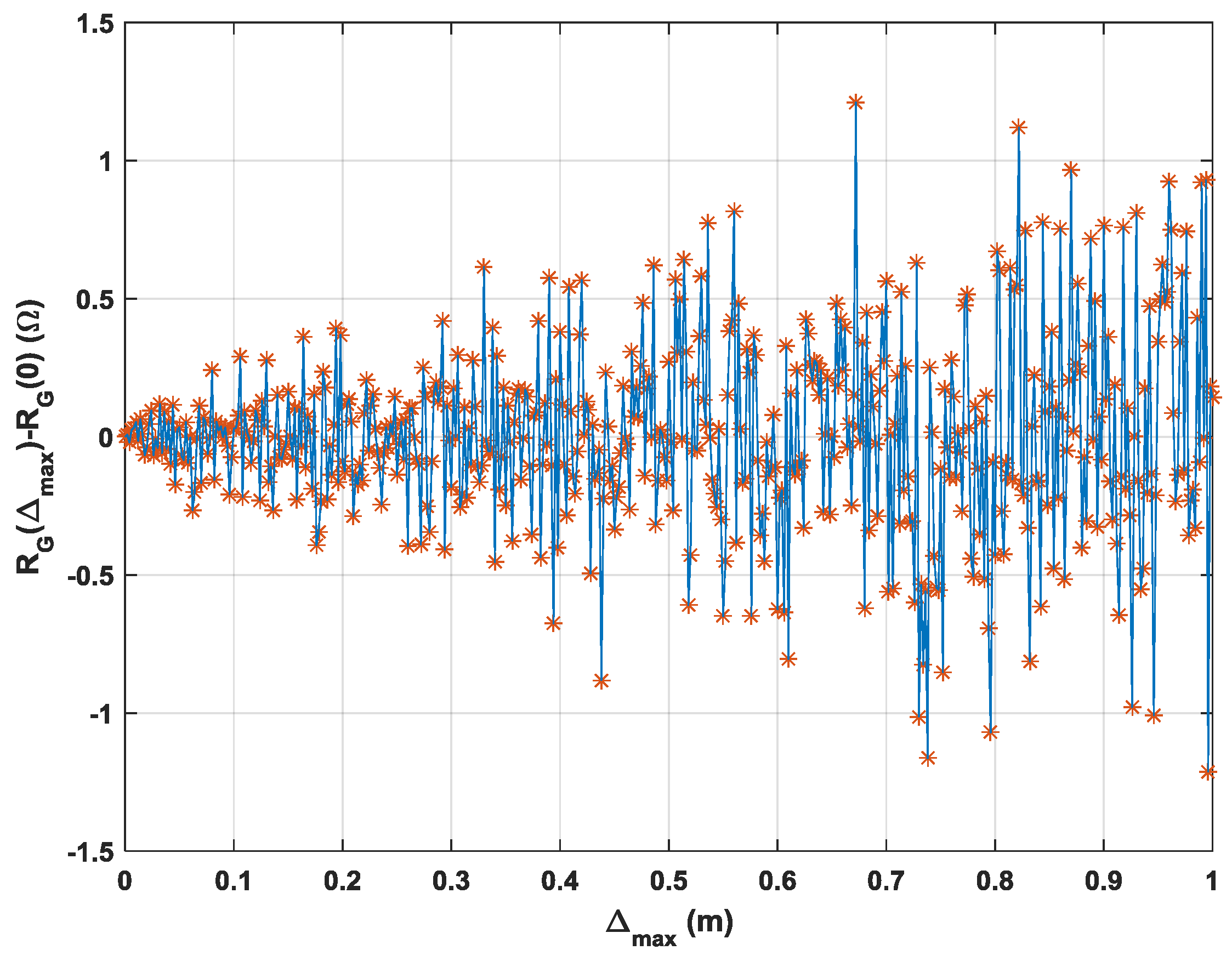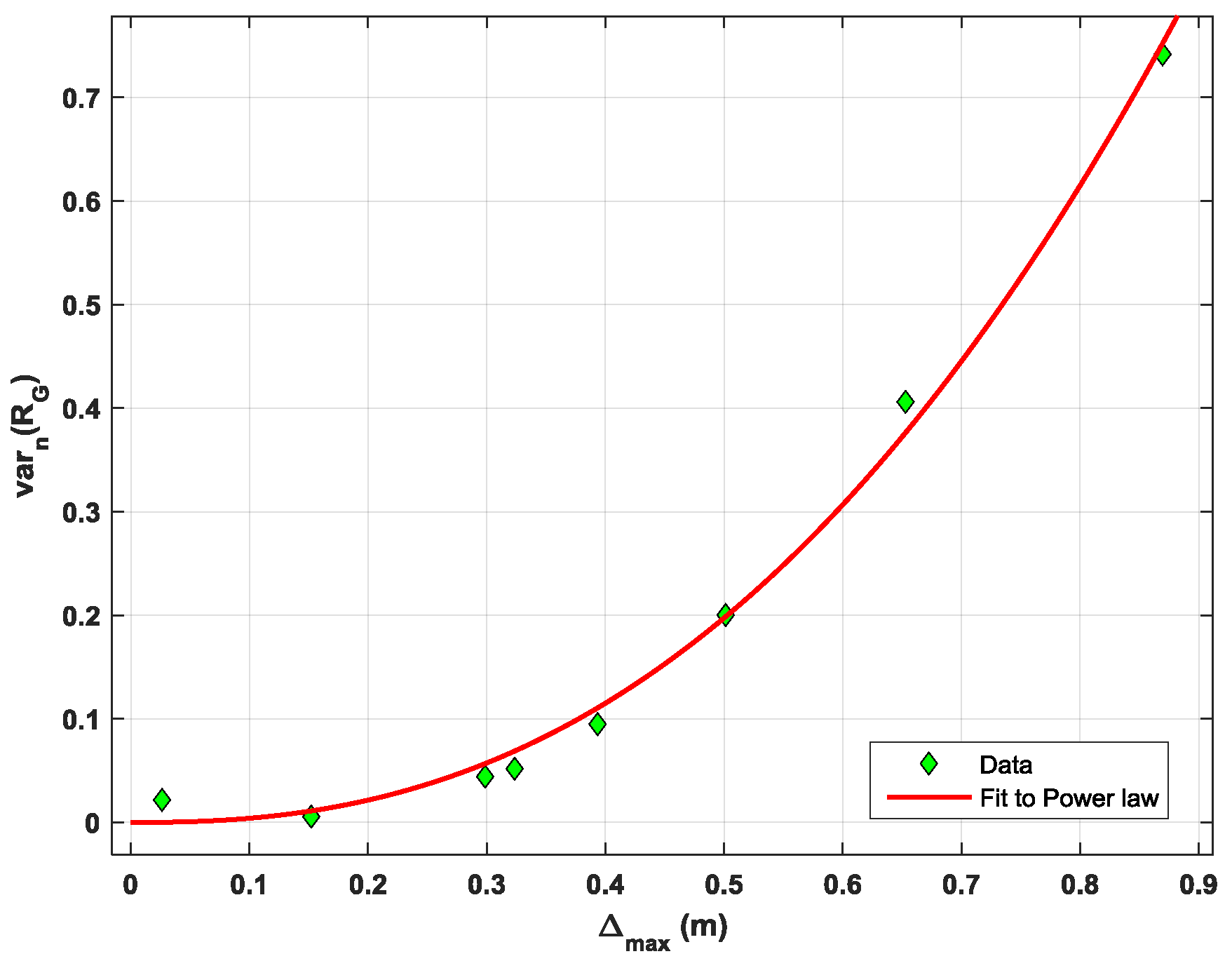1. Introduction
The grounding resistance is one of the most important parameters in the design of protection systems of electrical installations [
1]. Such resistance depends on the geometry and arrangement of the electrode buried in the ground and also on the nature and properties of the soil itself [
2]. With respect to the electrode, it is common to use thin metallic rods to construct a lattice, which is buried in the ground. As for the soil, it is frequent to use multi-layered models, which require horizontal layers of homogeneous conductive material and a perfectly flat and horizontal surface [
3].
The resistivity of the horizontal layers can suffer great variations for many different reasons. Variations in the content of water and mineral salts over time or the partial ionization of the terrain are some of them. This is one of the main sources of uncertainty in the calculation of grounding resistance. In this paper, another source of uncertainty due to a non-flat soil surface is studied.
Non-planar soil surfaces can be treated in case of the unevenness at small-scale of length is not significant and in addition, the amplitude of the unevenness is much smaller than the size of the measuring area (an almost-flat surface) [
4,
5]. However, the lack of flatness in the soil surface could lead to significant differences in the grounding resistance with respect to a flat surface. When irregularities also occur on a small scale on the surface, i.e., at the electrode size scale, the grounding resistance measures may contain large errors which must be taken into account in the design stage of the protection system of the electrical installation. In this work, the influence of an uneven soil surface on the measurement of grounding resistance is studied. The irregularity will occur on all spatial scales with a maximum intensity to be controlled in this study. For this purpose, a fractal landscape generator will be used and the resulting surface will be suitably meshed to use the boundary elements method (BEM) [
6] in the calculations. From a multi-layered soil with such an uneven surface, the grounding resistance of a proposed electrode is evaluated.
For this purpose, the paper is organized as follows. After this introduction, the soil model, along with its irregular surface and the theoretical foundation underlying all the calculations, is presented in
Section 2. In
Section 3, the results of the grounding resistance calculations are shown. Finally,
Section 4 presents the final conclusions of this work.
3. Stochastic Model for the Grounding Resistance
The theoretical model presented in
Section 2 is to be applied to the calculation of the grounding resistance of a complex electrode, as shown in
Figure 3, when the earth’s surface is uneven.
For this purpose, an uneven surface generator was used. The uneven surface chosen was built from a 2D fractal generator (FMW) based on the Mandelbrot-Weierstrass function [
13,
14]. The surface unevenness is associated with the variance of the stochastic process contained in the generator, not being allowed very extreme local values. The parameters defining the surface generated are
H, the pseudo-Hurst exponent, which controls the correlation between adjacent data, and
St, the unevenness strength.
H values ranging from 0 to 1 generate very spiky surfaces, while
H values >1 result in smoother surfaces which correspond to a strong correlation. Typical values used in this work were
H = 1.2 and
St = 0.1. As with any fractal structure, any portion of the generated surface has the same statistical properties of the entire surface, particularly the variability which is present at all length scales on the surface.
Using the FMW generator, a sample of 500 surfaces of two-layered soil characterized by
= 200 Ω·m,
= 113 Ω·m,
m were generated. These parameters will be referred to as the initial soil parameters and coincide with those measured at a place located in Madrid (Spain) used for electrical tests. The soils had a varied range of maximum unevenness between 0 < Δ
max < 1 m. For each generated soil, the grounding resistance of the electrode was calculated.
Figure 4 shows the relationship between the grounding resistance R
G and the ground unevenness
. The great variability of the series, which presents increased intensity fluctuations as
grows, can be seen.
It should be noted that for a specific uneven surface, the ground resistance may vary considerably by moving the electrode horizontally, as shown in
Figure 5, where the value of the electrode grounding resistance, when it was located at several different positions under the surface, is represented.
The subfigure of
Figure 5 shows the distribution of the calculated grounding resistance values for a soil with
= 0.5792 m when the electrode is placed in
N = 100 different positions under the surface in a radius of 50 m. A fit to a normal distribution was performed, having a mean value 22.5 Ω, which approximately corresponds to the value of the electrode grounding resistance for a flat surface, which is set at 22.59 Ω. From
Figure 4, the relationship between
RG and
may be interpreted as a single realization of a stochastic process which may be characterized by the following properties: (a) it is a non-correlated process; (b) it is stationary in mean with a value of
= 22.59 Ω, which correspond to the grounding resistance in a flat soil; (c) the variance is not constant but increases with
; (d) since it is built from the calculation of the grounding resistance in a soil with a self-similar surface, it must inherit some kind of self-similarity. The stochastic model
RG(
) must explain the variability found in the
RG calculation and provide an estimate of the variance which can be used for estimating the uncertainty in the
RG measure in a rough soil characterized by the unevenness level
. In this paper it is proposed by the simple model:
where
α and
β are constants to be determined, and
is an uncorrelated noise whose structure and properties are deduced from the analysis of the distributions as the sub-figure of
Figure 5. It will also be admitted that the random variable
is normalized, that is with a zero mean and unit variance. Note that Equation (10) is stationary in mean but not in variance. The variance of this process is
Figure 6 shows a realization of the stochastic process in Equation (1) when
α = 1.0 and
β = 1.2. If it is assumed that
RG(0) = 22.59 Ω, the series shown in
Figure 4 and
Figure 6 have a very similar general appearance, whenever it is taken into account that the series of
Figure 6 was evenly sampled while that of
Figure 4 was sampled according to the output of the FMW generator.
The actual values of the
α and
β parameters must be obtained from the variance of the
RG distributions associated with soils with a different unevenness level
.
Table 1 shows the estimated central variance of the assumed normal
RG distributions from N = 100 random electrode positions under a surface of unevenness level
. From the results, the parameters can be obtained by fitting the central variance to a power law,
.
Figure 7 shows such a fit procedure from which the values
a = 1.055 ± 0.088 and
b = 2.417 ± 0.263 are obtained. With respect to the coefficient
b, note that its value is closely related to the
H parameter since
, showing a clear connection between the surface soil structure and the measure the grounding resistance, so that finally,
and
.
Thus, a value of uncertainty in the measurement of the grounding resistance for a soil with an uneven surface
will be given by
, where σ stands for the standard deviation, which is given by the square root of Equation (11),
, thus
As an example, for a soil with m, then Ω and the uncertainty in RG is 0.71 Ω, which corresponds to around 3% of the expected value for a flat soil, which is 22.59 Ω. However, this percentage increases to 6% if the unevenness becomes m. It should be remembered that is an overall measure of the unevenness associated with the portion of the surface soil that contributes to the grounding resistance calculation.
It should be taken into account that both parameters
α and
β in Equation (10) will depend on the properties of the multi-layered soil and possibly also on parameter
H of the surface. This dependence can be investigated by numerical experiments with
, h and H as variables. With respect to
β, the dependence on the soil and
H parameters will have the general form
if the soil fits into a monofractal model, while it will have the form
if the soil fits into a multifractal model. In both cases, the function
can also be determined by numerical experiments while
is closely related to the multifractal spectrum of the uneven soil surface [
15].
The application of these results to the real world must begin with the assumption of a model that reproduces the irregularity of the soil surface. With regard to self-similar models, as discussed here, there are methods that allow us to find the H parameter from a natural terrain [
16]. With the calculation of the grounding resistance of a specific electrode from a flat soil surface, the actual resistance to be measured in the real terrain with a given maximum unevenness will have a confidence interval given by Equation (12) when the non-flat soil surface is considered as the only source of variability for the grounding resistance.

